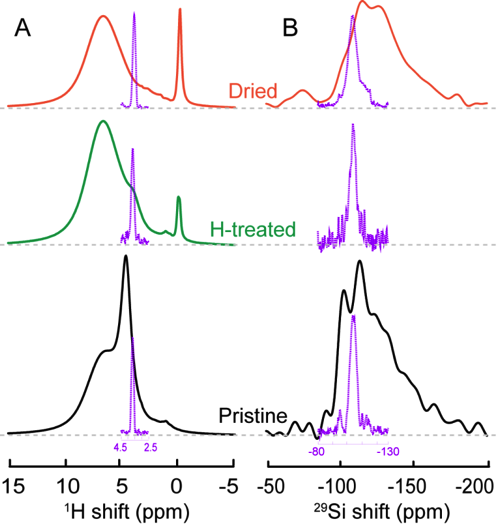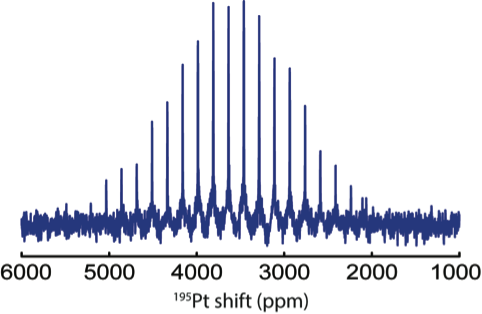Reports: DNI555373-DNI5: In Situ NMR Studies of the Hydrogen Spillover Phenomenon in Heterogeneous Catalysis
Yan-Yan Hu, PhD, Florida State University
Introduction
The objective of our research is to understand in sufficient detail how activated H atoms migrate from the surface of a catalyst to the surface of the catalyst support, i.e., hydrogen spillover (Fig. 1A). To accomplish this goal, solid-state NMR is employed to study hydrogen migration and participation in the reactions catalyzed by catalyst-metal oxide support systems, including Pt/SiO2, Pt/Al2O3, and Pt/TiO2.
Figure 1 A. Schematic representation of H spillover from Pt to metal oxide substrate surface, B. 29Si projection spectra and C. 1H projection spectra extracted from D. 2D 1H-29Si HetCor spectra of pristine, H2-gas treated, and dried Pt-SiO2.
Current Progress
The catalyst-metal oxide support composites, i.e., Pt/SiO2, Pt/Al2O3, and Pt/TiO2 were prepared following a reported method1.
Multinuclear multi-dimensional NMR experiments have been carried out to examine the surface structure of metal oxide catalyst support and Pt catalyst. Pt/SiO2 was first examined as a model system. Since surface H and SiO2 are most relevant to catalysis, 1H-29Si Heteronuclear Correlation (HetCor) experiments with 1H homenuclear decoupling have been performed to obtain high-resolution 1H and 29Si NMR of the catalyst support surface (Fig. 1D). In 2D 1H-29Si HetCor spectra, a peak at (dA, dB) is observed if a 1H species with a chemical shift dA correlates with a 29Si species with a chemical shift dB. As seen in Fig. 1D, a 1H resonance at 3.6 ppm correlates with a 29Si species resonating at -105 ppm. This 3.6-ppm resonance shifts to higher field (smaller ppm value) for Pt-SiO2 after drying at 200oC overnight. By comparing the total 1H NMR spectra of Pt-SiO2 before and after H2 treatment (Fig. 2A), we observe significant increase in the intensity and fraction of the 3.6-ppm resonance. This 3.6-ppm resonance may be the active surface H that participates in catalytic reactions. This can be further confirmed by the following studies: i) observe the change of this resonance for H2-treated SiO2 substrate only. If this 3.6-ppm resonance does not change with H2 treatment, participation of Pt is a necessary condition for splitting H2 into H and spill H over to SiO2 surface; ii) investigate D2-treated Pt-SiO2 and SiO2 samples. The –D or -OD groups on SiO2 surface can be from H (D)-spillover or direct H/D exchange, while the former requires the participation of Pt; and iii) Probe the change of the 3.6-ppm resonance before, during, and after catalytic reactions.
Figure 2 Comparison of 1D 1H and 29Si Hahn-echo spectra and the projection spectra from 1H-29Si HETCOR with the latter plotted in purple.
29Si spectra of surface Si species (Fig. 2B, purple plots) show very different features from those of the bulk. This demonstrates that the HetCor method is selective of structural environments on the surface of catalyst supports. Minor modification of SiO2 surface is observed in the presence of H2 by comparing the HetCor 29Si spectra before and after H-treatment (Fig. 1B). Spectra with improved S/N and resolution will be acquired for more detailed analysis.
195Pt NMR spectrum was acquired with Carr-Purcell-Meiboom-Gill (CPMG) pulse sequence and shown in Fig. 3. The large disposition (~ 3,500 ppm) of the peak center from 0 is due to interactions of Pt nuclei with electrons at Fermi level, which leads to Knight shift, typical of metals. The broad peak with a width of ~ 4,000 ppm pose challenges to build 1H-195Pt correlations. However, recent studies have shown that with fast sample spinning and low 1H background, it is possible to achieve 1H-detected 1H-195Pt correlations, which will be carried out in the near future.
Fig 3 195Pt NMR spectrum acquired with a CPMG pulse sequence.
Summary and Future Work
The possible spilled-over H species on SiO2 surface have been identified with high-resolution 1H-29Si correlation experiments, i.e. the 3.6-ppm resonance. The role of this 3.6-ppm resonance in catalytic reactions involving Pt-SiO2 will be further investigated through in situ and ex situ NMR experiments. H on Pt surface will be studied with 1H-195Pt correlation experiments. This investigation will be further extended to the Pt-TiO2 and Pt-Al2O3 combinations to understand the variation of the H-spillover phenomena in systems including catalyst-supports with different electronic conductivities. Manuscripts based on results obtained from this project will be prepared for submission in the next 6 months.
Impact on Career and Participating Students
This award has provided the opportunity for an African American female student, Ms. Alyssa Rose to participate in graduate research supervised by the PI and a senior postdoc. This project forms part of Ms. Rose's thesis on 'in situ studies of energy-related materials'. She has prepared her first manuscript on this project, gave a conference talk at the Florida Annual Meeting and Exposition (FAME), and will proceed to defend her PhD candidacy this October based on what she has achieved in understanding the Hydrogen spillover phenomenon. This grant also allowed the PI's research group to establish unique research capabilities for studying surface chemistry and its impact on catalytic reactions in real time with in situ NMR techniques. These capabilities form the foundation for achieving the PI's long-term career goals, i.e., to understand the interplay of surface chemistry and catalysis and to educate the next generation of scientists.
References
1. S. H. Joo, J. Y. Park, C.-K. Tsung, Y. Yamada and P. Yang, 'Thermally stable Pt/mesoporous Silica Core-Shell Nanocatalysts for High-temperature Reactions', Nat. Mater. 8 (2008) 126-131.














